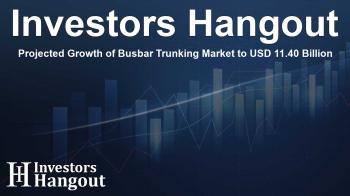Projected Growth of Busbar Trunking Market to USD 11.40 Billion

Busbar Trunking Market Size & Growth Insights
According to recent reports, the Busbar Trunking Market was valued at USD 6.56 billion and is projected to reach USD 11.40 billion, growing at a significant CAGR of 7.26%. This noteworthy increase is largely attributed to the rapid urbanization and expanding industrial infrastructure seen worldwide.
Factors Driving Market Growth
The rising need for efficient power distribution due to urbanization is crucial for various significant development initiatives. Busbar trunking systems are popular choices because they effectively supply power to commercial buildings, industrial plants, and residential complexes. Their constructional benefits—such as higher current-carrying capacities, minimized energy losses, and more compact installation requirements—make them particularly appealing.
Efficiency and Safety in Electrical Infrastructure
As industries shift from traditional electrical networks to more advanced systems, busbar trunking systems increasingly feature in discussions surrounding efficiency and safety. Their ability to manage high power in confined spaces while maintaining lower maintenance costs makes them indispensable in the modern landscape of commercial and industrial electrical infrastructure.
Key Players and Their Product Offerings
The market comprises several prominent players, showcasing robust competition:
- ABB Ltd.
- Siemens AG
- Schneider Electric SE
- Eaton Corporation PLC
- General Electric Company (GE)
- Legrand SA
- Larsen & Toubro Limited
- C&S Electric Ltd.
- Godrej & Boyce Manufacturing Co. Ltd.
- Rittal GmbH & Co. KG
- Anord Mardix Group
- E+I Engineering Ltd.
- Megabarre Group
- NAXSO S.r.l.
- Pogliano Busbar S.r.l.
- DBTS Industries Sdn Bhd
- EAE Elektrik
- P&S Power Technologies Ltd.
- Cuthbertson Laird Group
- Mersen Property
Market Scope and Segmentation
The busbar trunking market's current status and future outlook include detailed segment analyses, competitive landscape assessments, and regional trends.
Segmentation by Conductor
The market is segmented by conductor type, with copper holding a substantial market share of 60.50% as of the last fiscal year. It is anticipated to dominate the market due to its superior electrical conductivity and durability. Additionally, the aluminium segment is emerging as a strong contender, predicted to grow at a CAGR of 7.39% due to its lightweight nature and cost advantages.
Segmentation by Power Rating
When categorized by power rating, the medium power segment led the market previously, representing a significant revenue share. Fastest growth is expected in the high power rating category, with high-capacity systems now entering markets to serve manufacturing plants and other large-scale operations adequately.
Insulation Types
The sandwich insulation segment was notable, holding the largest share driven by its protective qualities during installation. However, air insulation is set to grow rapidly as well, thanks to its applicability in projects demanding lightweight and cost-effective solutions.
End-User Insights
The industrial segment previously dominated market revenue due to its high power needs, yet commercial applications are expected to grow significantly, driven by trends in smart buildings and energy efficiency.
Regional Market Insights
The Asia Pacific region leads the growth of the Busbar Trunking Market, promoted by the rapid industrialization and infrastructural development across major countries. North America is also witnessing considerable growth thanks to modernization efforts in electrical infrastructure.
Recent Innovations and Developments
- Recent advancements include Siemens' introduction of the SIMOCODE M-CP for more reliable and sustainable motor management systems.
- ABB's new ReliaGear™ Busway highlights innovations in low-voltage systems, emphasizing flexible installations and ease of use.
The busbar trunking market showcases a robust landscape marked by continuous innovations aimed at meeting the needs of modern infrastructure. As we move towards a more electrified future, the emphasis on efficiency and sustainability will only grow.
Frequently Asked Questions
What is the expected growth of the Busbar Trunking Market?
The market is projected to reach USD 11.40 billion by 2032, with a CAGR of 7.26% from 2025 to 2032.
What factors are driving this market growth?
Rapid urbanization and the expansion of industrial infrastructure significantly contribute to the increasing demand for busbar trunking systems.
Who are the leading players in the Busbar Trunking Market?
Key players include ABB, Siemens, Schneider Electric, Eaton, and GE, among others.
What are the primary materials used in busbar trunking systems?
Copper and aluminum are the main materials employed, with copper dominating due to its conductivity.
Which regions are leading the market?
The Asia Pacific region is currently leading, with North America also showing strong growth potential.
About The Author
Contact Riley Hayes privately here. Or send an email with ATTN: Riley Hayes as the subject to contact@investorshangout.com.
About Investors Hangout
Investors Hangout is a leading online stock forum for financial discussion and learning, offering a wide range of free tools and resources. It draws in traders of all levels, who exchange market knowledge, investigate trading tactics, and keep an eye on industry developments in real time. Featuring financial articles, stock message boards, quotes, charts, company profiles, and live news updates. Through cooperative learning and a wealth of informational resources, it helps users from novices creating their first portfolios to experts honing their techniques. Join Investors Hangout today: https://investorshangout.com/
The content of this article is based on factual, publicly available information and does not represent legal, financial, or investment advice. Investors Hangout does not offer financial advice, and the author is not a licensed financial advisor. Consult a qualified advisor before making any financial or investment decisions based on this article. This article should not be considered advice to purchase, sell, or hold any securities or other investments. If any of the material provided here is inaccurate, please contact us for corrections.

